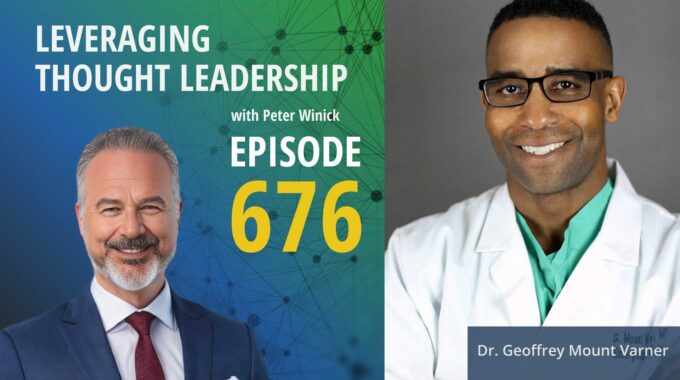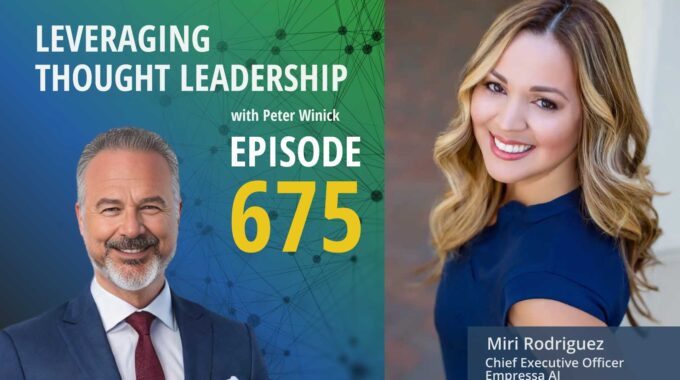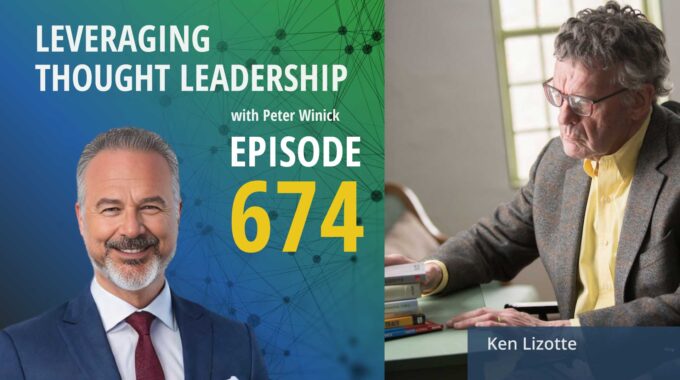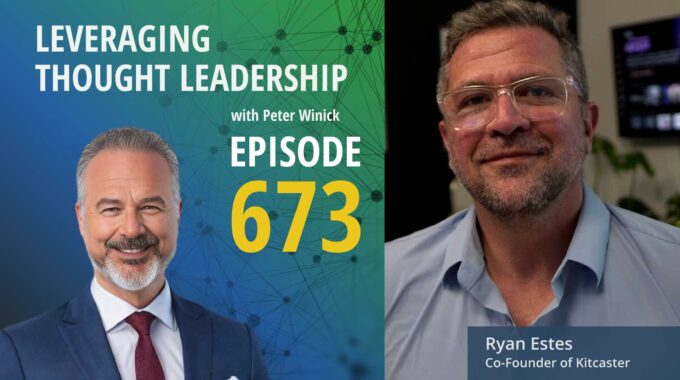The leadership advantage of acting with clarity, confidence, and purpose. This episode explores how leaders…
Getting Focused on Growth | David Ewing
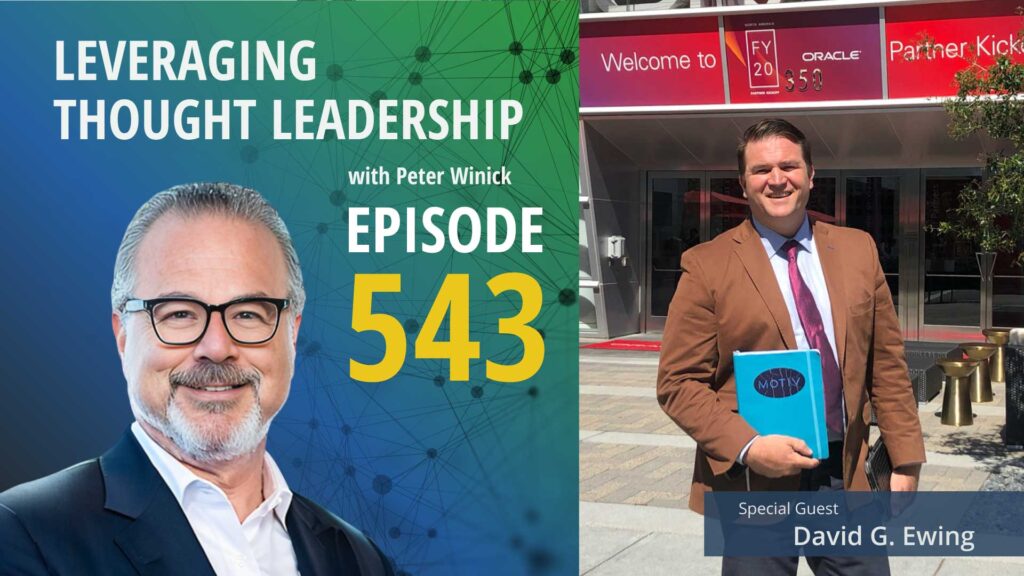
How having a narrow focus can make you more relevant.
An interview with David Ewing about finding focus in your mission and staying committed to the cause.
Should you try to make your thought leadership relevant to everyone?
Or, is being focused the answer?
To examine the effectiveness of “going narrow” with your thought leadership, I’ve invited David G Ewing to join me. David is a trailblazer in customer experience innovation, and the CEO of Motiv, the world’s largest Oracle CX exclusive partner allowing clients to manage their customer experience (CX) through every step of their journey.
David shares how he uses thought leadership to differentiate and drive business, by narrowly focusing on customer experiences using technology from a single vendor. This has allowed him to tackle any challenges a customer might bring his way.
David explains that a narrow focus allows him to find the exact target customer which is a match made in heaven for both sides. With thought leadership content focused directly on their pain points the customer knows from the outset the partnership is a good fit.
Part of finding that focus came from coming up with a mission and motive. David trimmed that down to a single word “Growth.” Having a one-word mission made it possible to have a lot of creativity while remaining focused.
David shares excellent advice for going deep for elevated relevancy!
Three Key Takeaways:
- The more focused you are the more useful you are despite being relevant to a smaller group of people.
- Having a good and clear mission statement can allow you to stay focused on your vision.
- It’s never too early to start thought leadership.
If you need a strategy to bring your thought leadership to market, Thought Leadership Leverage can assist you! Contact us for more information. In addition, we can help you implement marketing, research, and sales. Let us help you so you can devote yourself to what you do best.

Transcript
Peter Winick And welcome, welcome, welcome. This is Peter Winick. I’m the founder and CEO at Thought Leadership Leverage. And you’re joining us on the podcast, which is leveraging thought leadership. Today my guest is David G. Ewing. David is the CEO of Motiv. He’s a trailblazer in customer experience innovation that over 25 years in the industry, he’s transformed insights into substantial revenue for 500 plus clients, Harvard grad and engineering, which is interesting to be in the customer experience space coming from there. Motiv has been on the Inc 5000 list, he’s president of Entrepreneurs Association in Austin and has done a lot of interesting things on the thought leadership side, which is why he’s here today. So, David, welcome aboard.
David Ewing Thanks, Peter. Appreciate you having me.
Peter Winick So let me let me give you the first question is right. You’re on professional services. You’ve got an agency, customer experience, etc., etc.. I’m going to guess there’s lots of other agencies out there doing similar things. Obviously not as good as you. How is it that you’ve come to use thought leadership to differentiate the business drive business to you? Like, what’s the business case for you to decide to invest in thought leadership?
David Ewing Well, it’s, uh, you’re pretty spot on. I decided a long time ago that the more I focused, the more useful I was, despite being relevant to a smaller and smaller group of people. And, you know, where I had to take the business was I found that focusing entirely on customer experience, using a technology from a single vendor, which our vendor happens to be Oracle, was the way to really make sure that when a customer threw anything my way, I could handle it. The good news about being so narrow is that when you find that target customer, that that company that needs that service, uh, it’s a match made in heaven. But the problem, as I think you’ve rightly pointed out, is we’re not the only company out there who can do that. So there are dozens of companies who are boutiques who have similar specifications and capabilities to us. And so for us, it really comes down to, you know, why? Why did we bother doing this? And so really, it that came down to our mission, which, you know, there’s so many things written about a good mission statement. And, you know, most people have a mission statement. And I’ve been guilty of this in the past myself of having something that you could tear off of your one pager and put up at the muffler shop, and it would it would work. Right. And so, you know, uh, so it really what it came down to is we came up with a mission for motive, which was a little bit unique, which was one word. And that’s gross. And we realized that just giving us a single word, mission growth really allowed us to take and have a lot of creativity while still remaining with focused. And so it starts with the growth of our people. And, you know, there are lots of great consulting firms out there, but if you don’t have the best people, you don’t have the best firm just to get started. And so, uh, yeah, I.
Peter Winick Wouldn’t go back because there’s a lot here. So yeah, I went back to the niche piece. Right. So oftentimes what happens as a business owner is you want to bring in everything you can, right? You want to be all things to all people. Because at some level the lens is wider than we think it is in terms of who we can serve and how we can serve them. So it’s counterintuitive, but I would argue freeing to come to the realization that you’re incredibly irrelevant to most people most of the time. And the narrower and narrower and narrower, you can make that relevancy, right? Then you can spend all your time thinking about, how can I make myself more relevant to that very, very, very small population. So when they cross paths with me, there’s no need for them to even consider other because they just found their soulmate.
David Ewing That’s right. Yeah. And so for us, that soulmate is people who need customer experience and believe that customer experience, the best customer experience, will win. And when we look at potential customers in our space, if we don’t believe that we can triple their customer lifetime value, we just don’t gauge. And um, and so that’s really what we’re focused on is we’re interested in creating the magic of customer experience. That can lead to people just finding excuses to do business with our clients. And that’s really where it pays off.
Peter Winick So I think you made an interesting point, but you might have buried the lead a little bit, which is we want to talk to people that believe that. Right. So what do I mean by that? I think a lot of times smaller organizations, they’re nimble, they’re agile, etc., spend too much time trying to be in the conversion business. Right? So if you come across someone and they’re like, they don’t have that perspective, they don’t have that, you know, you know, what your vision is and what your mission is. If they need to be sold, that customer experience is important. Hey, you’re not getting paid to sell them to change their minds. Be. It takes a ton of work to change someone’s mind or an organization’s collective mind and see. Most importantly, if you did get them as a client, they’re probably going to be a client from hell because they’re not. So that belief piece, I think, is really, really important that some of the things that I’ve seen from a leadership perspective is it’s almost a self-selection mousetrap. I want to talk to people that already, you know, if you’re putting out there a lot of thought leadership on what you as an organization to believe to be, so then you’re really not arguing for debate. If you don’t, you’re kind of also saying to them, and if you don’t see the world this way, I’m probably not your guy. And that’s really okay for both of us.
David Ewing Absolutely. Yeah. I mean, there’s that old adage, right, that everybody loves to buy, but nobody likes being sold to. And I think we’ve just taken that to the next level. And we really bring thought leadership to bear. You know, we’re already talking about the things that we believe in and, and the strategies we believe in and how customers should be treated. And the wonder and the moments that matter will bring all of that in. Yes. The thought leadership then naturally gravitate towards people who resonate with that, and that’s who reaches out to us. And then we find the customers that we really want.
Peter Winick So when you look at that fine line between marketing and sales, thought leadership from a marketing perspective is actually qualifying warmer engagements may maybe not leads to the point of a sale immediately, but if it’s filtered out, folks, that wouldn’t be a good fit. That’s good too, because you’re not spending money. You know, spending money, time and effort talking to people that aren’t going to go anywhere, or writing proposals or RFP or whatever. How is it that you track the value the thought leadership is creating for you as an organization over a period of time?
David Ewing Well, it’s a little bit even more nuanced than that, because whenever we’re dealing with a sale, we’re dealing with usually far more than 2 or 3, sometimes five or even ten decision makers. And in that group, you’re going to get some people who believe what we believe. And you’re right, I don’t. And so if there is any selling in our process, what it is, is it’s merely the identification of who are the people who share our values, who understand the value of customer experience. And in that portfolio of folks that we’re going to meet, if that group can outweigh the other group, then that that’s where we go. So a lot of times what we do is when we are measuring this, we’re measuring in an individual opportunity, if you will. And as we’re evaluating it, we’re trying to just do a census of how many people are resonating with our belief system. And that really works out well. So it’s actually it’s not measured in terms of hundreds of, of different companies and things like that. It’s measured by individuals within an opportunity and who’s really there to kind of help us lead the way and transform a company into something that what they.
Peter Winick Want to stay there for a second. Because buying has become a team sport at an organizational level, right? The days of take your buddy out to the golf course, wink, wink, have a cocktail and he can sign that like that’s not happening anymore. I mean, maybe in some instances, but by and large, because the lines between so many things have been blurred, we need more people on the buy side, right. There’s a technology piece of compliance piece of whatever. Right. So if you look at a typical group, if there is such a thing of eight people on the buy side and say, you know what, I’ve got 3 or 4 that are on my team, 2 or 3 that are indifferent, and maybe 1 or 2 that are vehemently against what we believe in. Well, we’re probably not going to want to focus on the against, but if we can keep them in the in the minority, then what we could do is use thought leadership to feed those others in the middle that are more persuadable based on what we’re doing. So I think this is something that folks are using thought leadership for as well, saying, hey, we’re getting ready for a meeting. We had this conversation. Oh, funny you should mention that. I wrote a piece on this six months ago, or I did an article on that very issue last month or whatever, and you could show them other things that are memorialized in a piece of thought leadership to show. Hey, I’ve been thinking about this long before you brought it up. This is my point of view on it. How do you feel about that? Now? You might take a neutral and go, oh, I kind of dig. What? Yeah, that does align with my thinking. And he does that. Does that make sense to you?
David Ewing Yeah. We look at it as there are always lions and there are sheep in any situation. And so you know, lions can be for you or against you. And so if you can, if you can get the lions and those are really the people that we want to gravitate toward, resonate with. And the sheep will usually follow through. Exactly. So that’s, that’s really how we, how we work on it. So yeah.
Peter Winick And you get the Lions not by battling them but by showing them that, hey, we’ve got a lot in common. I think the way, you know, here’s how I can be helpful to you or what I say benefits your piece or whatever the case may be.
David Ewing It becomes their idea. Yeah.
Peter Winick If you’re enjoying this episode of Leveraging Thought Leadership, please make sure to subscribe if you’d like. To help spread the word about our podcast, please leave a five-star review at. Rate this podcast.com/l t l and share it with your friends. We’re available on Apple Podcasts and on all major listening apps as well as at thoughtleadershipleverage.com/podcast.
Peter Winick So I want to segue now into kind of made the case for thought leadership for your organization. How do you know we’re on a podcast now. So obviously that is a form of thought leadership. You coming on as a guest here. How do you decide where to put your stuff, what format, what modality? I mean, because that becomes once you sort of commit, like, hey, thought leadership is a benefit to my business. It opens up a whole bunch of other questions. So how have you wrestled with that?
David Ewing I have wrestled with it mightily. And, uh, and it’s been a long time, and I don’t have any silver bullet answers, but I will share my journey. My journey starts in kind of a funny place with thought leadership, because I went to college and yeah, I got to go to Harvard and that was great. And there’s a whole story about that. But as I went there, I really thought very consciously about where my career was going to go. And between 18 and 22. Believe it or not, I thought that the height of career for me would be to go back to Detroit, where I’m from and run a family business. We had a beautiful manufacturing company and it was wonderful. But, you know, after four years of preparation and internship and design and study, my father flies out to Boston in the middle of my senior year and says, hey, um, you know, there’s not going to be any clear succession plan. And I have a feeling you’re going to get halfway through your career and then it’s going to fall apart, and I’m not going to let that happen. So we’re selling the company now. Go figure it out. Like you’ve got to do something else with your life. And so four years of preparation I’m 22 years old and I’ve got my first massive my career is over before I started. And I’ve got if you got.
Peter Winick Fired before you got.
David Ewing Hired. Exactly. Yeah. I mean, it was just like, okay, well let’s pivot now after four years of this.
Peter Winick And so that, uh, is there that sounds like boomerang nepotism or something. Yeah.
David Ewing Yeah. So it was, uh, it was a massive pivot at a moment and I really wasn’t ready for it. And, uh, and so, lo and behold, I went out to Silicon Valley and started an apprenticeship with, like, a really great consulting firm. And they were the dream for me. They were absolutely amazing. It was all these, like, really brilliant people. I was there and I just started to get really involved in the senior partners were wonderful right up until this moment, two years in, when I had this idea for how we could expand and build out a practice, and one of the senior partners just looks at me and is like, David, just kill it, man. Like all we do is answer the phone here. And it was just the most devastating moment of my life in my in that career. And I’ll tell you what, I worked there for another six months, and they had my body and they had my brain, but they lost my heart right at that moment. And so, yeah, you know, at age 24, I wound up starting my own consulting firm. And I’m actually something starting a consulting firm in your 24 is like marketing new wine, you know, it’s like wine, fresh new wine. You don’t need that old stuff, you know? I mean, it’s like it’s a terrible position to be in, right? But it was where I started. And so thought leadership began right there. And, you know, I would say that it’s been interesting because I’ve, I’ve tried to take the approach with thought leadership of make sure that whatever I’m speaking about, I have a strong technical competence and, and detailed data to talk about from a, from a position of authority. And I’ve done that. And I’ve never been successful in getting like bigger and bigger, mostly because I just feel I realized recently that if you trace back the last 20 years of my thought leadership, I’ve always played small ball. I’ve always done things that were, hey, I’ll go talk at this conference, sure, or I’ll go write this paper. But I’ve never started like a YouTube channel and started putting things out there. And it’s really been something where, you know, in the last six months, as I became president of the Entrepreneurs organization that I realize, like, hey, there’s a lot of people out here who like what I have to say. And I finally just developed the confidence to just say, well, it’s time to stop playing small ball. And so I have a message now that I believe appeals to a wider group of people. I’m I’m looking for those VP of sales and those CMOs who really want to just make magic happen in their company. And I just have a lot more to say. And so my thought leadership journey is now kind of going to the next level as I start to do those kinds of things, and I’m introducing my own website, all that other stuff.
Peter Winick I mean, let me ask you a chicken and egg question. And so could that even have been a possibility at 24, or did it take the years and years of dabbling with it to develop a perspective and a deep body of work, as well as 20 years of experience in the marketplace?
David Ewing Yeah. Fair question. And the question I asked myself, Peter, is I don’t I think the answer is no. Couldn’t happen at 24, even if there was enough social media presence to have done it. But what about 34. Yeah. By then. Yeah, I think that could have been it. And now I’m 47. Right. So it’s been 23 years, so I don’t think I needed to wait quite this long. Should have started a lot sooner. But I’m here now and that’s where it is. But, uh, yeah, I think that, uh, I could have played, uh, on a bigger scale a lot sooner. I just needed the, the, the ego to, to be able to do it. And I mean ego in the best sense of the word.
Peter Winick Yeah. And I think that’s a bigger, you know, that that bigger scale as we, as we start to wrap up here, is really a piece that people don’t understand when it comes to thought leadership, which is you probably have competitors that are five or 10 or 20 times your size or have been around longer or have offices in 50, whatever. Right? So you can’t outspend them, right? But you can outthink them. You could be smarter than them. And thought leadership is an even playing field. Because if you’re smarter than your, you know, your competitors or as smart or whatever, you can amplify that and go big with the thoughts. If regardless of the resources, the size, the whatever. Yeah, probably not naming a stadium in your in your local community after your company. So there’s things you can’t do. But if you got really wicked smart ideas, you can unleash the power of them. And I always say it’s like, yeah, go big or go home. I don’t do thought leadership that’s limited to your local chamber of commerce. That’s you’re missing the point, then you’re right.
David Ewing You’re absolutely right.
Peter Winick Cool. Well, this has been fun. I appreciate your time and thank you for sharing your journey with us. David.
David Ewing Peter, thanks for having me.
Peter Winick To learn more about Thought Leadership Leverage, please visit our website at ThoughtLeadershipLeverage.com to reach me directly. Feel free to email me at Peter at ThoughtLeadershipLeverage.com, and please subscribe to Leveraging Thought Leadership on iTunes or your favorite podcast app to get your weekly episode automatically.


